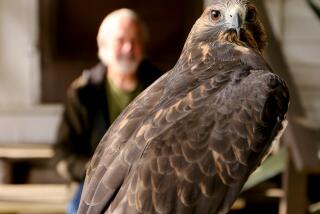Moorpark neighbors battle infestation of rabid bats
Linda Cree and her husband haven’t dared to go outside to sit by their pool in the two months since furry black bats began invading their Moorpark backyard.
They found three drowned in the pool, she said. Some flopped around on the ground in a pitiful death dance before growing still. She found one clinging to her screen door when she went out to get the morning paper, said Cree, 65, a homemaker.
Of the eight bats she reported to Animal Control, seven tested positive for rabies. The eighth one got away before the workers arrived, she said. She no longer gardens, even during the day, and the couple have given up entertaining.
“You can’t have people over for a barbecue when rabid bats are falling out of the sky,” she said as she held her Yorkie, whom she no longer takes outside to relieve himself.
Cree’s situation may be the most dire in a Moorpark neighborhood that has been invaded by an unusually large number of bats, many of them rabid. In the last two months, 10 bats have tested positive for rabies.
Moorpark officials have traced the bats to five homes within four blocks in a tract of tidy stucco homes squeezed in between the 118 Freeway and the southern edge of Moorpark Community College.
Three homeowners have taken steps to seal the bats out from the eaves of the Spanish-tile roofs where they like to nest, said John Brand, a city vector control official. Two other property owners have been less proactive and are now being forced to carry out eradication, he said.
One home on Linville Court was quarantined by Ventura County Health Officer Robert Levin on Tuesday after authorities confirmed that two rabid bats came from a nest beneath the roof tiles. One bat bit the homeowner, Steve Spence, and another one was picked up by a dog that had been let out on the patio.
Spence is receiving multiple vaccinations for rabies and his 7-month old bulldog, Pumba, has also been given shots and quarantined. Moorpark officials ordered Spence to remove the bat colony by Friday or pay to have a city-contracted exterminator do the work.
On Friday morning, Spence’s girlfriend, Miriam Quintero, found Steve Balderama, a San Pedro trapper who was willing to do the dirty work for $1,000 — far less than the $2,000 to $4,000 they had been quoted. Balderama said he usually charges more but took pity on the couple, who have struggled since Quintero was laid off from her security job two years ago.
After surveying the home, Balderama decided to seal the bats inside the Spanish tiles by drilling a fine-mesh screen into the roof line. Then, near the peaked top of the roof, he attached a box trap that he hopes the animals will wander into as they begin to emerge at dusk.
“In essence, I’m creating a one-way door out,” said the 22-year-old trapper.
Balderama usually spends his days removing raccoons and hunting down coyotes, he said. Bat trapping is so rare that he had to improvise his system. He worried that the bats would not move into the trap and would instead die after being unable to leave the tiled eaves.
He pulled on a beekeeper’s mask and thick gloves before climbing a ladder to begin the work. After three hours, he was done. The bats occasionally emitted agitated screams, but did not attempt to leave the colony.
As Balderama did his work, life on the surrounding streets continued in its usual rhythms and some residents said they weren’t too worried about the bat infestation.
The city passed around brochures a few weeks ago, asking residents to be aware of bats and on the lookout for ones that had fallen to the ground. They were instructed not to touch them and to call animal control instead, said Nancy Szilaji, 53.
Szilaji has lived in her house for 18 years and said she’s has never had a problem with bats. Of much greater concern are the dive-bombing swallows that take over several streets every spring, she said, leaving behind mud nests and white muck on cars.
Maxine Benoit, 74, lives on nearby Melray Street, where three separate bat colonies have been identified. She said bats have never been of great concern to her because she doesn’t see them. But as a precaution, she has been keeping her two dogs inside.
“I check the yard to make sure none of them have dropped,” she said.
Cree, who lives directly behind Spence’s home, said her home likely became a focus for the bats because of her proximity to the nest. She said she’s frustrated that it took two months of calling officials to finally see the problem addressed.
But she’s not mad at her neighbors.
“The bats chose them,” she said. “What can they do?”
catherine.saillant@latimes.com
More to Read
Start your day right
Sign up for Essential California for news, features and recommendations from the L.A. Times and beyond in your inbox six days a week.
You may occasionally receive promotional content from the Los Angeles Times.







